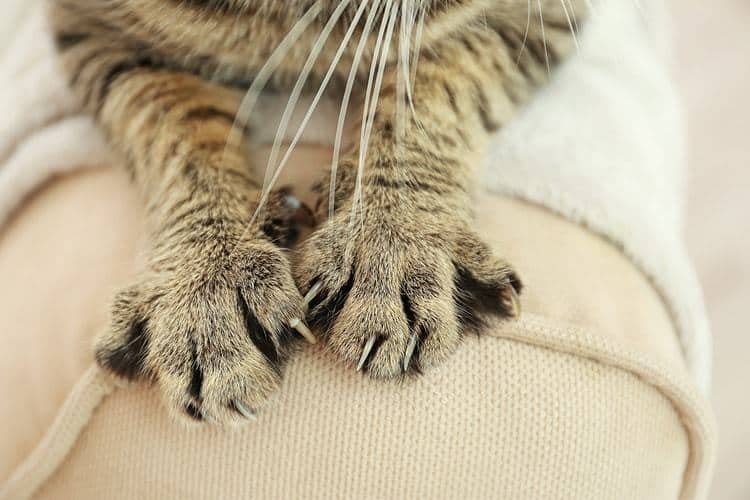One of the biggest purchases that goes into a home is the furniture–nothing makes a room like a big cozy sectional, a stately chaise lounge, or an overstuffed armchair by the fire. Of course, nothing really compliments a cozy chair quite like a content, sleepy feline. However, most cats can’t help but sharpen their claws on the sturdy legs and sides of both wooden and upholstered furniture, causing irreparable damage and a lot of frustration. Luckily, with a few simple strategies, you can keep your cat and your couch in great condition for years to come.
Step 1: Try to Establish Boundaries
Whether you are introducing a new kitten to a household, or a new piece of hard-earned furniture to your home, establish consistent boundaries of where your kitty is allowed on furniture. This requires constant vigilance on your part, for at least a week: whenever your cat sits down in front of (as if to scratch) your furniture, have a rattle can or a shaker ready to haze them away. Make noise, shake that can vigorously! You might find it easier to train a cat to stay away from furniture altogether–either way, the cat learns quickly that it doesn’t want anything to do with furniture.
Step 2: Try an Herbal Approach
Cats have a very keen sense of smell; along with their whiskers, it makes them fierce hunters–but it also makes them very sensitive to offending odors. To keep your cats from shredding the legs on your new farmhouse-style kitchen table, try adding a few drops of lemon, bergamot, tangerine or grapefruit essential oil to a non-toxic furniture oil, and wipe them down, leaving a heavenly scent that offends most cats. Lavender and clove are also effective–you can easily mix a few drops with water in a spray bottle to spritz parts of the couch that are being attacked. But make sure to do a small patch test on the fabric first to avoid staining.
Step 3: Install a Scratching Post
Some cats could care less about a loud noise, and simply lack a good surface on which to preen their claws, which grow continually and slough off layers of keratin, needing constant upkeep. There are many options for scratching posts available–from eco-friendly recycled cardboard models, to elaborate cat tree houses, but keep in mind while the cardboard scratching posts are affordable, they also create a fair amount of dust and cardboard bits. If you are more into a DIY approach, it’s easy enough to make your own with some simple sisal rope and some wood.
Step 4: Trim Your Kitty’s Nails
If your cat doesn’t seem interested in the scratching post or is still searching for something to shred, it might be time to trim their claws. This can be a bit tricky, but a nail clipper with a larger grip can make the job much easier. Make sure to practice using it a few times before you try it on your cat, to avoid any traumatic mishaps. Try to just remove the very ¼” tip of the claw, just the sharp portion that can rip up the fabric. Use cat treats, or an herbal remedy like Bach Rescue Remedy to relieve any anxiety during the process. If your cat is particularly moody, it might be wise to enlist another pair of hands the first few times you attempt trimming your cat’s nails–and if they really put up a fuss, most groomers charge less than $20 to do it for you.
Step 5: Make the Furniture Unappealing
Don’t worry, you don’t have to wrap your couch in a plastic cover to protect it from your cats–but if you really want your furry friend to stop using as a scratching post, try covering the sections of the couch the cat likes to scratch, particularly while you are away from home for a period of time. Just grab a fitted sheet, and tuck it loosely around the area, or even just drape a throw blanket over either side. Do this for a few weeks, and be sure to place a scratching post nearby, that’ll convince even the most stubborn feline to behave.
Step 6: Cat Manicure Time
If your cat can’t be persuaded to leave the sofa alone, a solution might be to apply cat nail caps. They work by covering the sharp tip of the cat’s claw with a little silicone tip glued painlessly to the claw using a non-toxic glue. They seem fussy to apply, but they are only needed on the front paws, and a full set can be installed easily by one person, as there is no pressure or pinching involved. They are highly recommended by veterinarians, and each application lasts about 6 weeks. The cat might still practice ‘scratching’ but their claws will be covered by the dull, slippery silicone cap and they won’t make a mark on your couch!
Featured Image By: Africa Studio, Shutterstock




















